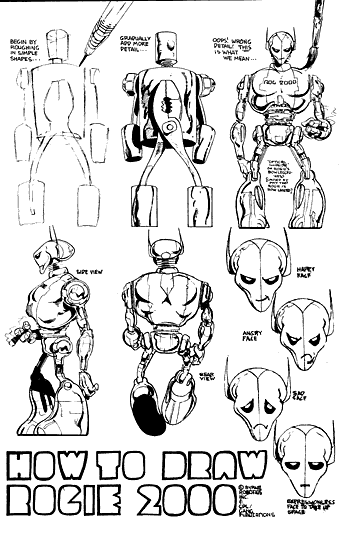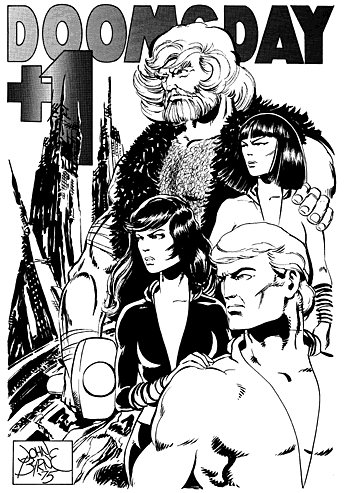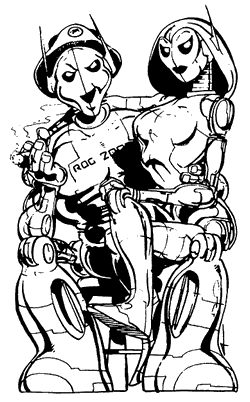 From the original art courtesy of Nick Cuti, here a "How-To"
Rog-2000 page from CPL #8 drawn by John Byrne. Rog-2000 ©2001 the
respective copyright holder. By permission of Bob Layton & CPL/Gang
Productions.
From the original art courtesy of Nick Cuti, here a "How-To"
Rog-2000 page from CPL #8 drawn by John Byrne. Rog-2000 ©2001 the
respective copyright holder. By permission of Bob Layton & CPL/Gang
Productions.
Byrne's Robotics
The prolific Marvel/DC stalwart on his big break at
Charlton
Conducted by Jon B. Cooke
From Comic
Book Artist #12
Does John Byrne, superstar comics artist/writer really need an
introduction? Well, suffice to say it didn't take long for John
to attain a huge fan following for his early "Iron Fist"
and X-Men work after he arrived at Marvel following his first professional
tenure at Charlton comics. But if you were astute enough to follow
the titles of the Derby, Connecticut publisher in the mid-'70s,
you may have seen the artist's accomplished debut on such fondly-recalled
books as Doomsday +1, "Rog-2000," and, yes, Wheelie and
the Chopper Bunch! This interview took place via e-mail on April 14,
2000.
Comic Book Artist: You mentioned in an interview that your
first full-length comic story was Death's-Head Knight back in
the early '70s. What was that?
John Byrne: Not sure I would actually have called it my "first
full-length comic story." Death's-Head Knight was a project
done for the Alberta College of Art, which I was attending at the
time. The curator of the gallery had brought in a comic art show,
and needed a "brochure" to be given away at the door. He
asked me if I could prepare something on relatively short notice,
and I did, some 20 pages, each double-width. It was a sword-&-sorcery
story.
 Doomsday +1 pin-up by John Byrne. Characters ©2001 their respective
copyright holders. Courtesy of Bob Layton & CPL/Gang Productions.
Doomsday +1 pin-up by John Byrne. Characters ©2001 their respective
copyright holders. Courtesy of Bob Layton & CPL/Gang Productions.
CBA: What was your college-era series Gay Guy? Was it a Sunday-
or daily-style strip? How long did it last?
John: The College was located on the campus of the Southern
Alberta Institute of Technology (SAIT), and the SAIT newspaper was
called the Emory Weal. On the back page they ran a truly terrible
"humor" strip called Fat Faggot, which was wretched in every
possible way. (Aside from what we would now consider the Political
Incorrectness of the strip, it looked as if it had been drawn on the
back of an envelope with a ball point pen.) I knew I could do better,
even then, and put together my own strip, about a homosexual super-hero
called Gay Guy. Also a humorous strip. (My, my, how times change,
eh?) It ran about half a year, weekly, before I grew frustrated with
the abysmal printing and abandoned the strip.
CBA: Who was John Mansfield? Did he have connections at DC
and Marvel?
John: John was a Canadian fan who also happened to be in the
Armed Forces. He saw the Death's-Head Knight book, and got in
touch with me through the college. He offered to show my work at cons
and to connect me with various people in the biz, which he did. We
made a grand total of one trip to New York City together, and he introduced
me to Roy Thomas. The rest of his contribution was getting my stuff
published in various fanzines, and connecting me with The Monster
Times, which published my first "official" work.
CBA: During the early '70s, were you consistently sending
samples to the New York publishers? Did you seek work at Charlton,
Skywald, Atlas/Seaboard, Warren?
John: I did a lot of work for 'zines like Chronicle, Epoch,
and CPL, but I did very little hawking of my wares to the companies
directly. I sent only one thing that might have been considered a
"submission," and that was a Captain America sample which
I prepared at the request of Steve Englehart, who was writing Cap's
book at the time, and thought it might be fun to have a Canadian artist
illustrate a story he had planned, in which Cap encountered a Canadian
super-hero. That connection was set up by John Mansfield. The story
never happened, and in any case, the work was rejected as unready
for publication.
CBA: Who was Duffy Vohland and what happened to him?
John: Duffy is dead. He died several years ago, of some horrible
wasting disease. He was one of those peripheral people who seem to
populate comics, working at the Marvel offices for several years,
but never quite managing to rise beyond a certain level. He wanted
to be an inker, but he never quite made it. He saw my work in Epoch—he
was part of the Indianapolis Mafia that consisted of Roger Stern,
Bob Layton, Roger Slifer and Epoch published Steve Mattingly—and
started pushing for me to get work at Marvel. It was because of Duffy
that Tony Isabella saw my work, and gave me my first official Marvel
assignment.
CBA: How do you recall the genesis of Rog-2000?
John: I was doing a lot of spot illos for 'zines, mostly
for Stern's and Layton's CPL (Contemporary Pictorial Literature).
One of the doodles I sent in was a robot with his arm blown off. Layton
and Stern turned this into an editorial gag illo, and, since there
were several Rogers involved in CPL at the time, Layton named him
ROG-2000. Then they asked for more drawings of the same robot. Since
I had no access to a Xerox machine, I did not have a copy of the original
drawing, so I recreated the character as best I could from memory.
Later, Stern wrote a ROG-2000 story for CPL, which I illustrated.
It was on the strength of this that Nick Cuti asked if I would like
to do ROG for a backup feature in E-man, which he would write.
 Rog-2000 making woo with a certain Rogette in a John Byrne drawing
from CPL. Courtesy of Bob Layton & CPL/Gang Productions. Rog-2000
©2001 the respective copyright holder.
Rog-2000 making woo with a certain Rogette in a John Byrne drawing
from CPL. Courtesy of Bob Layton & CPL/Gang Productions. Rog-2000
©2001 the respective copyright holder.
CBA: What was Byrne Robotics and who helped out in Canada?
John: Back when I was starting up I was very nervous about
using uncredited assistants. I did not want the folk at Charlton knowing
I was not doing all the work myself, but I also did not want the work
credited as if I was. So I came up with the term "Byrne Robotics"
as the credit whenever I had help on the books—such help being
nothing much beyond spotting blacks. Two people helped out as "Byrne
Robotics," my college chum Vic Bosson (now a successful illustrator
in Canada) and his girlfriend, Barb Weaver.
CBA: Did you initially do illustrations for the text pages
of various Charltons? Do you recall the work?
John: Once I started working for Charlton, Nick and George
Wildman looked for anything and everything they could find to keep
my plate full. I think they guessed that Marvel or DC would scoop
me up pretty fast if the Charlton work lagged (which is pretty much
what happened), and they gave me a few of the text pages to illustrate
more or less as time-filler. I was already working on full books for
them, at the time, so those text illos were not my starting point
with the company.
CBA: How did you get the Wheelie and the Chopper Bunch gig?
What was it about the strip you found interesting? You mentioned in
an interview that Hanna-Barbera requested that you "tone-down"
your initial story. Do pages exist that weren't published or
did you revise the original pages?
John: Wheelie and the Chopper Bunch is what I consider my first
"full book"—entire issues with nothing but my work
on the main pages. It was the most work Charlton was able to offer
at the time (a short while before Doomsday +1), and I took it with
the intended approach that, if I was going to do a book like this,
then I would be the Carl Barks of Wheelie and the Chopper Bunch! Unfortunately,
H-B thought my drawings were too "scary" (they were published
unchanged in my first issues, so judge for yourself), and insisted
that Charlton order me to tone it down. That kinda sucked the fun
out of the book, and I became very robotic in my approach, just drawing
the pictures and not really putting anything into them. I found myself
unable to work that way, and quit the book to concentrate full time
on Doomsday, which was in the offing by then.
CBA: Any contact/memories of Joe Gill and George Wildman?
John: I'm very grateful for the start they helped me get—especially
Joe who told me I was free to rewrite as much or as little of his
scripts as I wanted when I drew and lettered them. That gave me a
good opportunity to practice form and content.
CBA: Did you ever visit the Derby offices? Did you visit the
bowling alley/editorial offices? Any memories to share?
John: To this day I have not been anywhere near Derby, and
it's not all that far from where I live, now!
CBA: Recall the genesis of Doomsday+1? Was there any co-plotting
with Joe? (Joe recalls it as a highpoint of his writing career.) Any
idea what the thinking was behind the strip— (that is, was it
a take-off, of sorts, on Space: 1999?
John: Not sure how you might think Doomsday +1 was a "take-off"
on 1999. They were very different books. As I understand the genesis,
they simply wanted to do a post-Armageddon book, one of those barbarians-riding-giant-grasshoppers
kinds of things, and as it evolved in script form it became Doomsday
+1 as we saw it. Joe Staton was originally set to draw the first issue,
with me coming on with #2, but George decided that was kind of silly,
and had me do Doomsday +1 from the get-go. Joe very kindly re-wrote
some of the first issue script to include some Canadian references.
CBA: Doomsday +1 really showcased your talents and, combined
with the Rog-2000 back-ups, readers started to take notice of your
work. Did you start receiving mail about your work? Any memories?
John: One of the strangest of all the reactions to my very
early professional work, to me, was the number of people who said
they loved it so much because I was obviously inspired by the Japanese
Manga works, and Japanese animation. Which was very odd, since all
I was trying to do was draw like Neal Adams, and I had seen only one
Manga (which one of my College profs brought back for me from a "field
trip" to Japan), and had seen none of the animation.
CBA:What was the first con you attended as a pro? Experiences?
John: That would have been Seuling con, in 1974. I had just
made my first sale—to Marvel—and so qualified as a "pro"
on a technicality. It was a strange experience. My first exposure
to fans en masse. I remember thinking "This is the audience.
. . ?" and wondering if my future lay elsewhere. I mentioned
this to John Romita, when I had the chance to chat with him at a cocktail
party one of the evenings of the con, and he told me I should not
worry about that, as the people who turned up at conventions, like
the people who wrote letters, were not considered representative of
the audience as a whole.
CBA: Recall your page rate for interiors and covers? Could
you make a living off of Charlton's rates?
John: Answering backwards, no. After about six months I was
making $50 a page for pencils, inks and lettering at Charlton, which
was their top rate. This was in the days when I was also working as
a designer for Hook Signs, an outdoor advertising company in Calgary,
my home town. When I started getting work at Marvel, at $35 a page
for pencils alone, I was able to leave Hook, and ultimately Charlton,
and concentrate on comics full time.
CBA: You were quoted as saying, "I had a lot of fun at
Charlton," and said it was a great place to hone your skills
for the bigger publishers. Is that so and, if yes, can you elaborate
and assess your Charlton experience, now 25 years later?
John: Charlton comics were, at that time, only a couple of
steps above fanzines. They had poor printing and terrible distribution,
and they allowed me to hone my craft off in a corner where very few
people really noticed. (To this day, I find that my greatest curse
is that the best work I do is the work I know no one is ever going
to see. For years I have maintained sketchbooks specifically to this
end, drawing anything and everything, never letting anyone see them—I
destroy them when they are full—and hoping that the developments
and growth which occur there will eventually slop over into the published
work. Which it usually does.) At Charlton I got paid to mess around
and experiment, and I'm very grateful to them for that opportunity.
I very much doubt I would be the artist I am today, had I not had
that fairly loose foundation upon which to build.
CBA: Was there any plans to do a Rog-2000 book at Charlton—did
you lobby for one? Do you own copyright on the character?
John: We talked about a Rog book, and I even came up with a
full-length story idea, a sequel to the sewer-monster story that was,
if memory serves, the last published Rog story at Charlton. I think
I even laid out a cover. But Charlton was not interested, and Marvel
was beckoning rather relentlessly at that point. I'm not sure
anymore who owns Rog. I had a handshake from George Wildman to the
effect that Rog would always be mine, but we all know what Samuel
Goldwyn said about verbal agreements! In any case, it has been so
long since I did anything with Rog, I would not be at all surprised
if the copyright has lapsed. Pity, really.
To make subscription and back issue orders easier for our readers (especially
those overseas), we now accept VISA and MASTERCARD on our secure
web store! ( Phone, fax,
mail and e-mail
accepted, too!)
 

Sign up here to receive periodic updates about what's going on in
the world of TwoMorrows Publishing.

Click here to download
our new Fall-Winter catalog (2mb PDF file)
|



